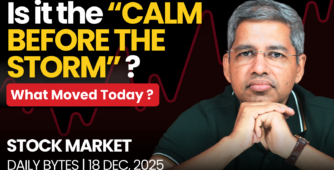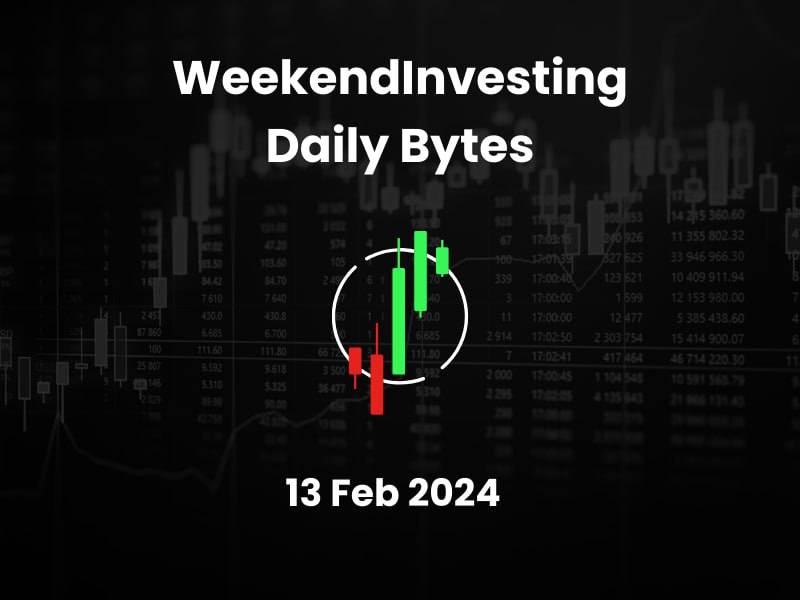
How are the Markets Looking ?
The stock market’s landscape on February 13, 2024, was a testament to the unpredictable nature of financial markets, where initial panic can swiftly turn into recovery, highlighting the resilience of certain sectors. The day began with the Nifty 50 index showing signs of distress, dropping to a concerning level below 21,600, a significant figure that had previously acted as a resistance zone around 21,700 points. This early panic set the stage for what appeared to be a tumultuous day for investors.
However, the markets showcased their dynamic character as the Nifty 50 made a commendable recovery, closing the day up by 0.6%. This turnaround was largely attributed to the banking sector, which saw a significant recovery after a period of decline. Banking stocks, particularly those in the Nifty 50, which have a considerable influence on the index due to their weightage, played a pivotal role in this resurgence. The recovery of banking stocks, both in the public and private sectors, was crucial for the market’s overall performance, indicating the sector’s substantial impact on market movements.
Despite the day’s recovery, there remains a sense of unease regarding the market’s direction. The inability of the Nifty 50 to surpass certain levels and the recent breakdown after reaching a new all-time high have left investors waiting for global cues and contemplating the market’s future trajectory. This period of consolidation, although a natural part of market cycles, brings with it a sense of discomfort, underscoring the importance of cautious optimism in trading and investing.

Nifty Heatmap
ICICI Bank led the charge in the banking sector with an impressive uptick of approximately 2.3-2.4%. HDFC Life also showcased positive momentum with a 2.15% increase, while Kotak Bank rose by 1.6%. SBI Life wasn’t far behind, posting a gain of about 2.2%, whereas HDFC Bank saw a modest rise, remaining largely flat with a 0.3% increase. This marked a commendable day for the banking sector overall, significantly contributing to the index’s performance.
On the IT front, the scenario presented a mixed bag, with standout performances from Wipro and TCS bucking the trend, whereas the majority of IT stocks faced challenges. Tech Mahindra, however, managed a respectable increase of 0.73%. Amidst this, Coal India emerged as the Nifty’s star, boasting a remarkable gain of 4.52% at a time when many stocks showed weakness, highlighting its exceptional relative outperformance.
In contrast, Hindalco encountered a tough day, with a significant loss, alongside Grasim, which also faced a downturn. Despite these setbacks, the market overall saw a robust recovery across various segments, illustrating the dynamic nature of the stock market landscape.
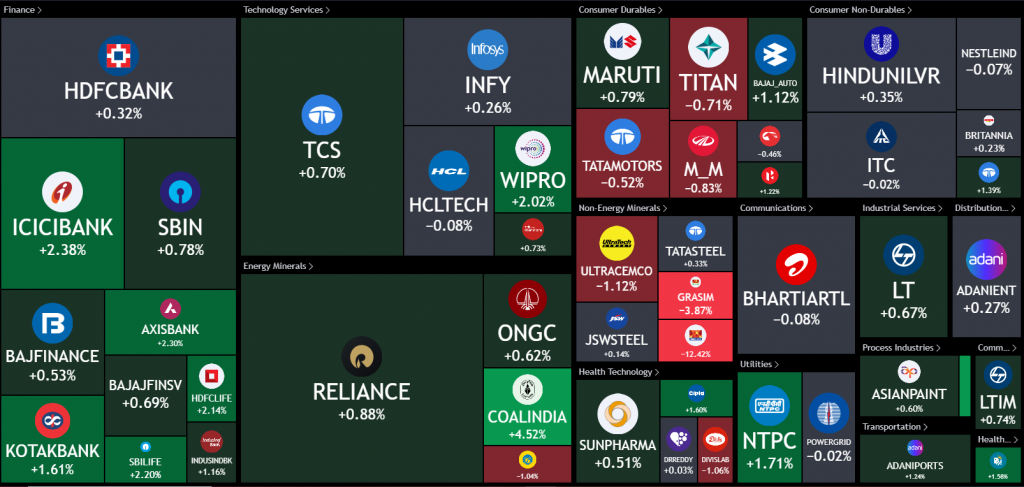
Sectoral Overview
In today’s sectoral overview, the banking sector, particularly private banks and PSU banks, led the charge, registering gains between 1.2% to 1.5%. Public Sector Enterprises (PSE) stocks also saw a healthy performance, with almost 1% gains. This movement propelled the Nifty 50 index to a 0.6% rise. Interestingly, this uptick in Nifty was predominantly driven by these heavyweight sectors, indicating their significant impact on the market’s direction, despite the majority of the tracked sectors lagging behind Nifty’s performance.
On the flip side, the metals sector experienced a notable decline, shedding 2.1% today, and reflecting a 6.1% loss over the past week. This downturn highlights its position as one of the weaker performers in the current market landscape. Conversely, PSU banks have shown remarkable resilience and growth, topping the charts with a robust 14.7% gain, underscoring their strong standing amidst market fluctuations.
This analysis becomes particularly relevant in light of the market’s recent downturn over the last four sessions, where PSE stocks have notably withstood the pressure, maintaining a solid performance over the last three months. This resilience amidst market volatility underscores the critical role these sectors play in stabilizing and influencing market trends.
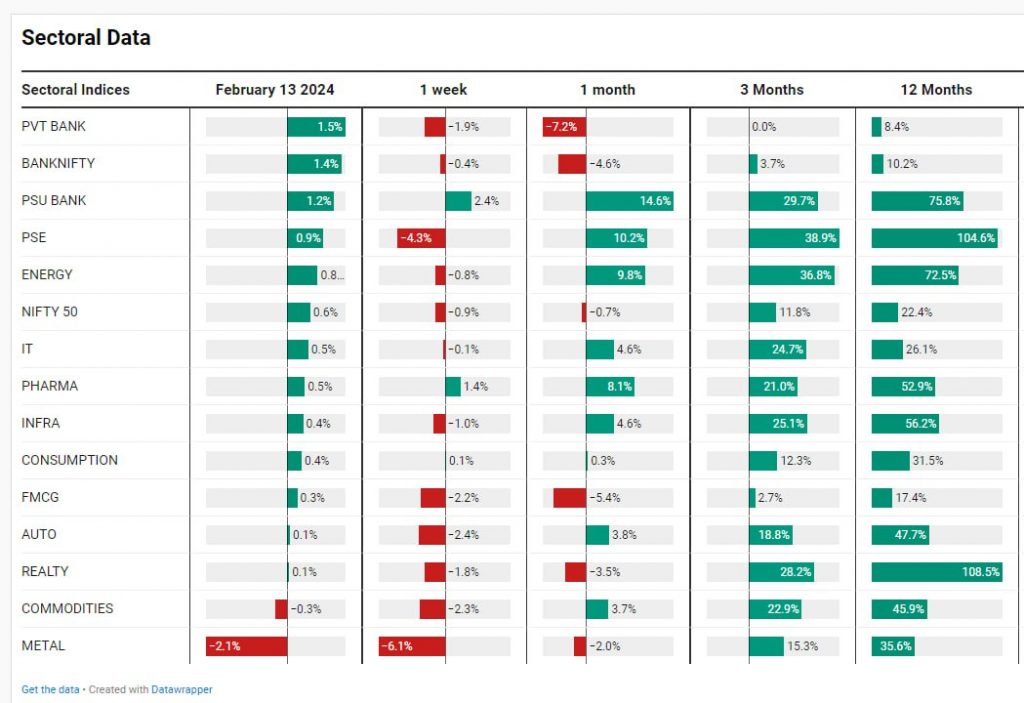
Mid & Small Cap Performance
The mid-cap sector showcased a notable recovery, marking a significant rebound from attempts to drive the index to lower levels. This resilience not only ensured a close well within the previous session’s range but also hinted at a potential easing of the recent market woes, at least in the short term. Observers are now keenly watching to see if the mid-cap index will continue its revival and breach the resistance level of 17,800, a development that could signal a broader market recovery.
Similarly, the small-cap 250 index echoed this recovery narrative, demonstrating a strong bounce back. An important figure to watch in the coming sessions is the 14,700 level, which could be pivotal for future movements. Despite experiencing an approximate 8% decline from its peak to its recent low, the sector’s resilience suggests a cautious optimism for a revival. Such movements are critical indicators of market sentiment and could offer insights into the next phases of market trends, which we’ll delve deeper into in our upcoming analysis.
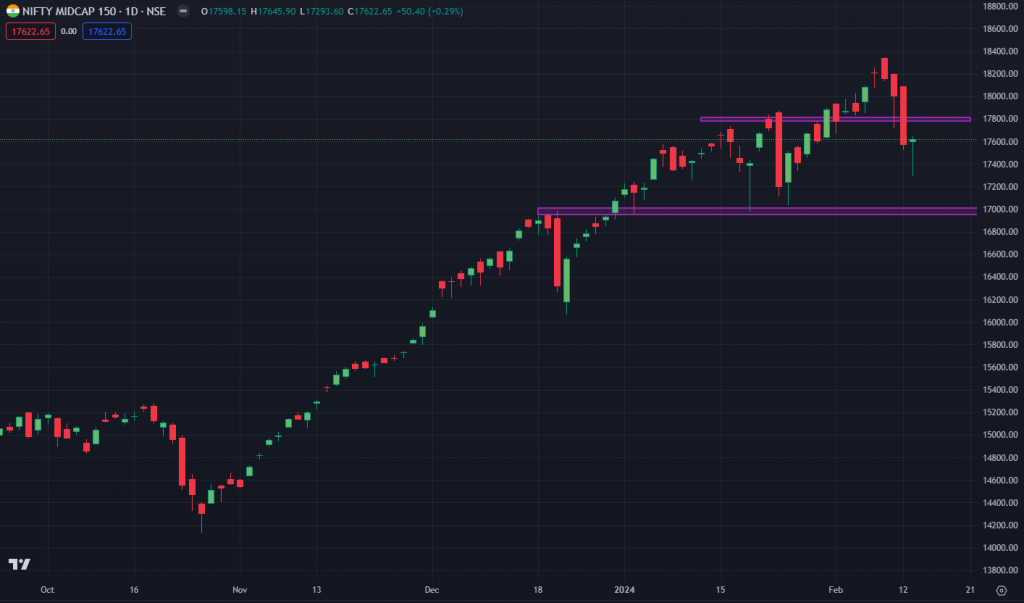
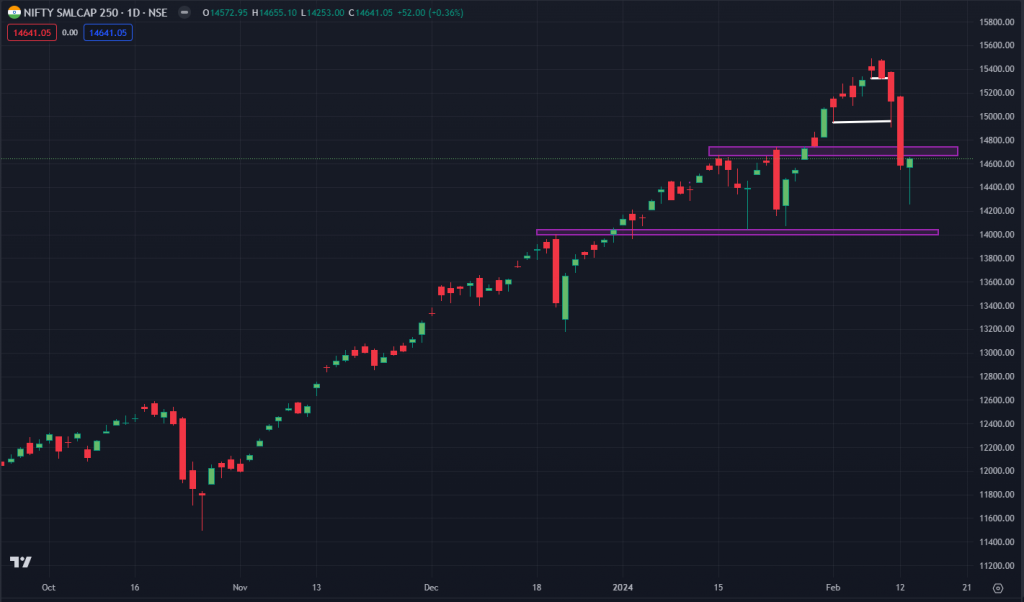
Nifty Bank Overview
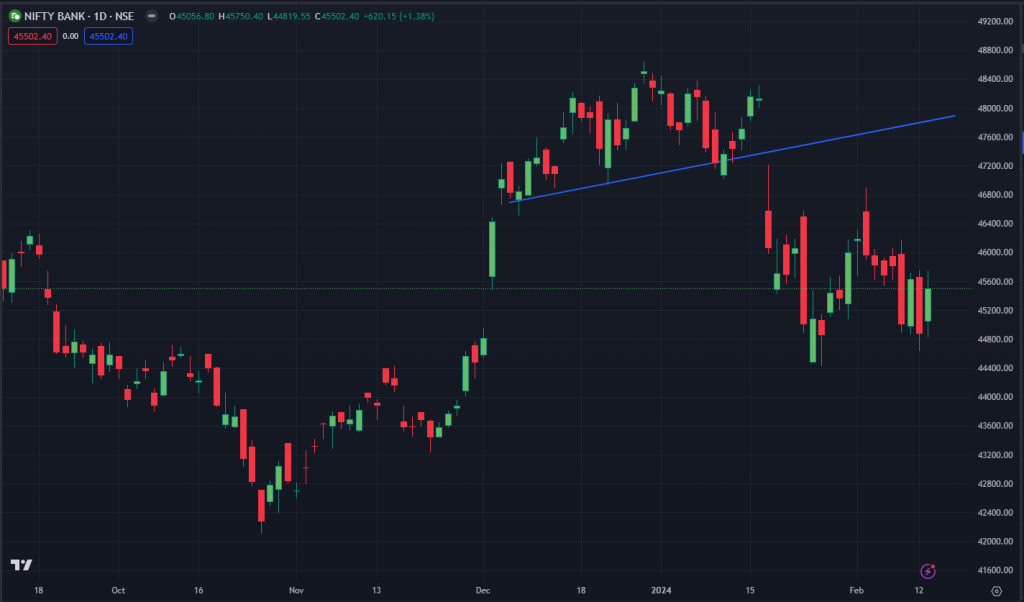
Highlight – Smallcap’s Recent Downturn
In the ever-fluctuating realm of the stock market, the Nifty small cap index’s recent downturn by nearly 8% has sparked a flurry of concern amongst investors. This decline, observed over just a few sessions, highlights the inherent volatility that comes with small cap investments. The market’s reaction serves as a poignant reminder of the critical need for clear investment objectives and an understanding of one’s risk tolerance.
The case in point involves reflecting on why one chooses to invest in small caps. Is it due to the fear of missing out (FOMO) on the exceptional performance seen in small cap products over the last year? Or is there a deliberate strategy behind this choice, grounded in a well-considered asset allocation plan? This distinction is crucial for investors to understand their positions and the potential implications of their investment decisions.
Historically, the small cap index has showcased periods of significant growth, followed by prolonged phases of consolidation. Such patterns indicate that impressive gains often come with high risks, particularly for an index known for its volatility. The recent dip, although alarming for some, is part of the broader market’s cyclical nature. However, it raises important questions about the investor’s endurance and strategic planning in face of market downturns.
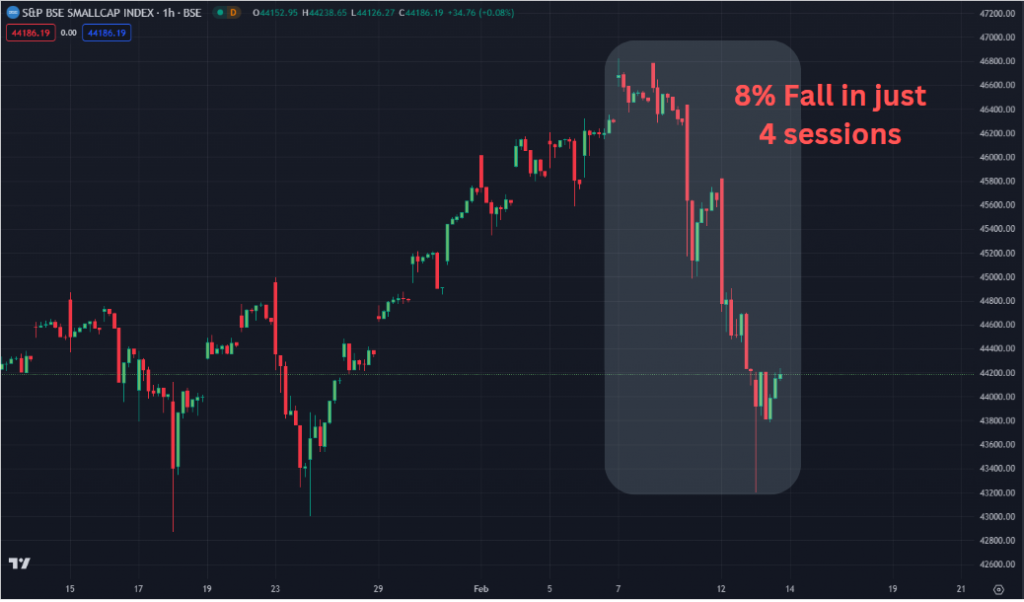
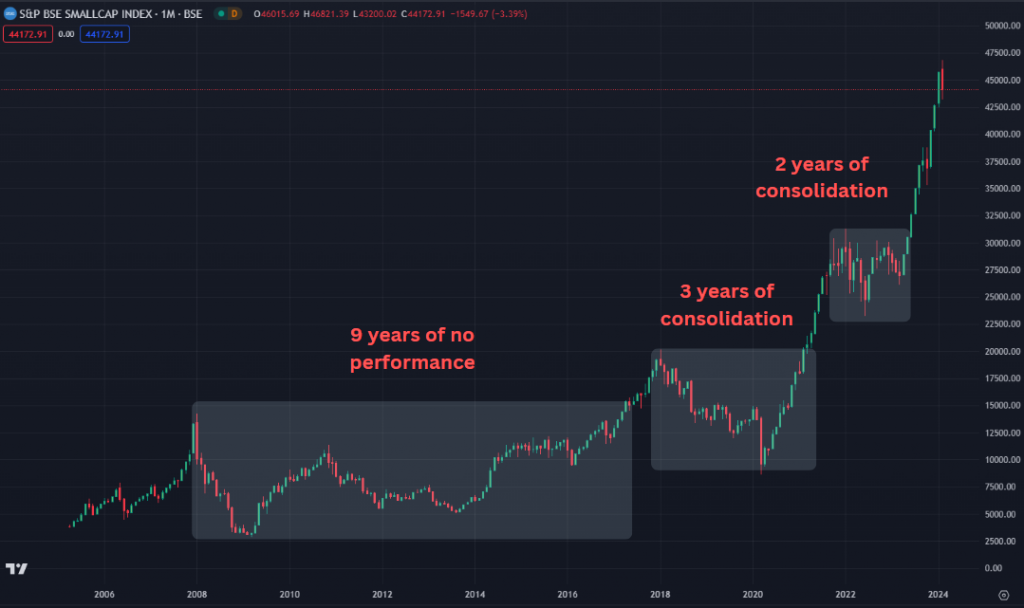

If you have any questions, please write to support@weekendinvesting.com




